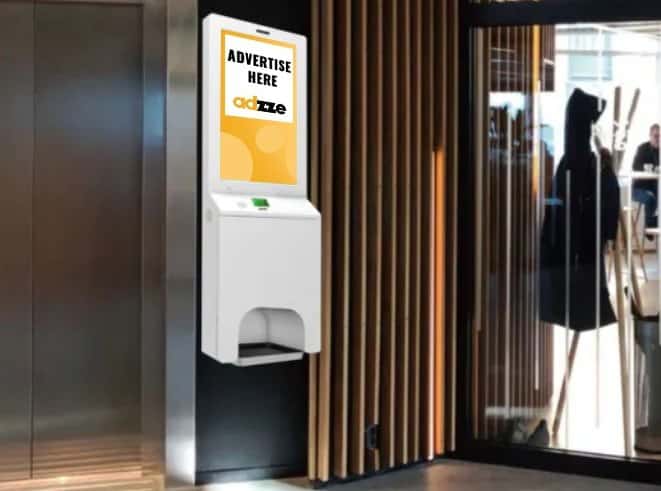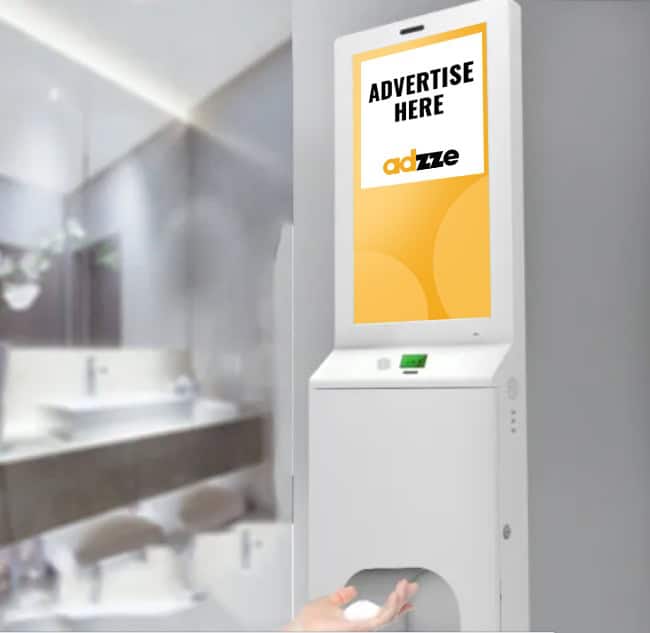Why Advertising with Sanitizing Kiosks is a Game-Changer
In the evolving landscape of out-of-home (OOH) marketing, advertising with sanitizing kiosks has emerged as an innovative and highly effective way to engage consumers. Positioned in high-traffic locations such as malls, airports, gyms, and office buildings, these kiosks provide an essential public service while doubling as a prime advertising medium.
However, as with any marketing strategy, brands must assess their return on investment (ROI) to ensure advertising with sanitizing kiosks delivers measurable business outcomes. In this blog, we’ll explore how to track and optimize ROI, uncover key performance indicators (KPIs), and share best practices for maximizing returns.

Why Advertising with Sanitizing Kiosks Works
Before diving into ROI measurement, let’s explore why advertising with sanitizing kiosks is gaining traction among marketers:
Undivided Attention – Consumers pause to use sanitizing kiosks, providing a prime moment for brand engagement.
High-Traffic Locations – Positioned in entryways, food courts, gyms, and airports, these kiosks guarantee exposure to diverse audiences.
Extended Dwell Time – Sanitization takes a few seconds, ensuring your message is seen without distractions.
Public Health Association – Associating your brand with hygiene and well-being fosters consumer trust and positive brand perception.
With these advantages in mind, the next step is determining how to effectively measure the ROI of advertising with sanitizing kiosks and refine strategies for maximum impact
Defining ROI in Advertising with Sanitizing Kiosks
Return on Investment (ROI) is calculated by comparing the revenue generated from a campaign against the total costs involved. However, advertising with sanitizing kiosks differs from traditional ad placements because consumer interactions are often indirect.
Basic ROI Formula for Advertising with Sanitizing Kiosks:
ROI=Net Profit from Campaign−Cost of CampaignCost of Campaign×100ROI = \frac{\text{Net Profit from Campaign} – \text{Cost of Campaign}}{\text{Cost of Campaign}} \times 100ROI=Cost of CampaignNet Profit from Campaign−Cost of Campaign×100
However, since advertising with sanitizing kiosks focuses on brand awareness and engagement, ROI measurement must include impressions, engagement rates, and conversion tracking.
Key Metrics for Measuring ROI in Advertising with Sanitizing Kiosks
Ad Impressions and Reach
Why It Matters: Measuring how many people see your ad is the first step in assessing campaign impact.
How to Measure:
Foot Traffic Sensors – Track the number of individuals passing by the kiosk.
Screen Display Data – Digital ad platforms track how many times an ad is shown.
Pro Tip: Cross-check foot traffic data with venue demographics to ensure your message reaches the right audience.
Dwell Time and Engagement Rates
Why It Matters: Longer exposure to an ad increases message retention.
How to Measure:
QR Code & Shortlink Scans – Track user interactions with special offers.
Touchscreen Interactions – Some kiosks allow engagement with interactive ads.
Pro Tip: Use compelling CTAs like “Scan for 20% Off” to boost engagement.
Brand Recall & Awareness
Why It Matters: Sanitizing kiosks provide high-visibility placements that improve brand recall.
How to Measure:
Post-Campaign Surveys – Ask consumers if they recall seeing your ad.
Brand Lift Studies – Measure awareness and sentiment before and after exposure.
Pro Tip: Offer survey incentives (e.g., discounts) to increase participation rates.
Conversion Tracking & Attribution
Why It Matters: Ultimately, brands need to track whether advertising with sanitizing kiosks translates into business actions.
How to Measure:
Promo Codes & Discounts – Assign unique codes to track redemptions.
Geo-Fencing & Retargeting – Use mobile technology to re-engage consumers who passed by a kiosk.
UTM Tracking on QR Codes – Monitor customer journey from kiosk ad to digital actions.
Pro Tip: Pair kiosk ads with limited-time offers to drive urgency and immediate conversions.
Best Practices to Maximize ROI in Advertising with Sanitizing Kiosks
Design for Maximum Impact
Keep it simple, bold, and visually striking. Kiosk ads should be:
Concise & Readable – Use short, impactful copy and large fonts.
Visually Engaging – Leverage bright colors and eye-catching graphics.
Action-Oriented – Feature a clear call-to-action (CTA), such as “Scan for a free sample.”
Tailor Content to the Venue & Audience
A targeted message ensures higher engagement.
Location-Specific Examples:
Gyms – Advertise protein bars, fitness apps, or workout gear.
Malls – Promote fashion deals, loyalty programs, or restaurant offers.
Airports – Feature travel insurance, car rentals, or luggage brands.
Integrate Kiosk Ads into an Omnichannel Campaign
Advertising with sanitizing kiosks shouldn’t stand alone. Sync it with:
Social Media – Encourage users to share their experience via hashtags.
Retargeting – Serve follow-up ads to users who engaged with your kiosk ad.
Cross-Promotion – Align kiosk messaging with in-store promotions.
Pro Tip: A multi-channel approach strengthens brand exposure and recall.
Monitor, Test & Optimize
Tracking tools like Google Analytics, CRM integrations, and QR code scans allow marketers to adjust strategies for better results.
Optimization Strategies:
A/B Test Creatives – Try different ad formats, colors, and CTAs.
Test Timing & Locations – Some kiosks perform better at peak hours.
Analyze Data Regularly – Use insights to refine messaging and targeting.
Real-World Success Stories of Advertising with Sanitizing Kiosks
Case Study: Beverage Brand in High-Traffic Malls
A soft drink company ran a sanitizing kiosk ad campaign in shopping malls, offering a QR code for a free sample at nearby stores.
Results:
40% QR code scan rate
25% increase in foot traffic to participating stores
Higher social media mentions due to interactive experience
Case Study: Fitness App Promotion in Gyms
A health & wellness brand advertised its fitness tracking app via sanitizing kiosks in gyms, encouraging users to download the app for free workout plans.
Results:
30% increase in app downloads
Higher gym engagement & referrals
Boosted brand trust by aligning with health & hygiene






